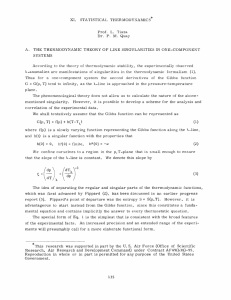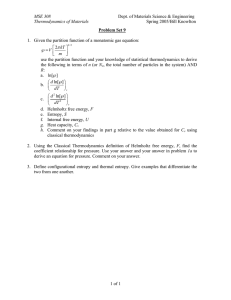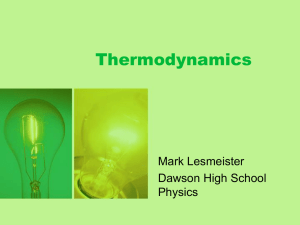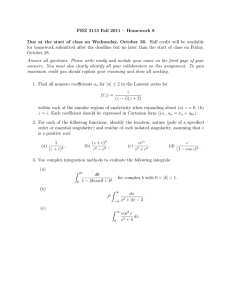XIII. STATISTICAL THERMODYNAMICS Prof. L. Tisza
advertisement
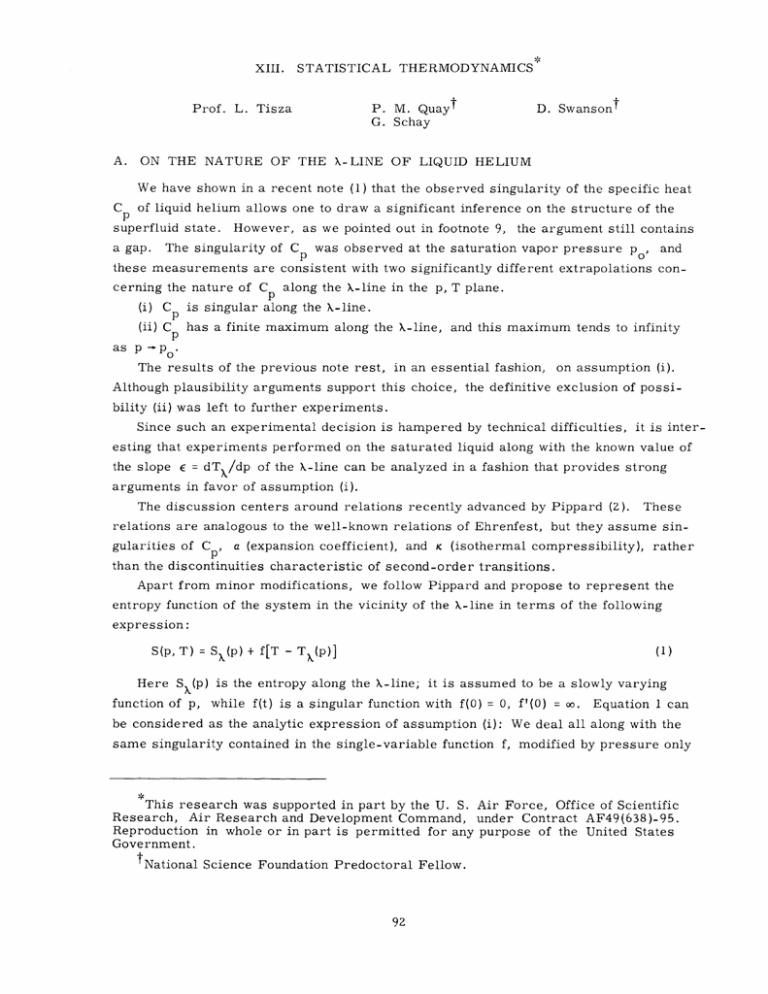
STATISTICAL THERMODYNAMICS XIII. Prof. L. A. Tisza P. M. Quayt G. Schay D. Swansont ON THE NATURE OF THE X-LINE OF LIQUID HELIUM We have shown in a recent note (1) that the observed singularity of the specific heat C of liquid helium allows one to draw a significant inference on the structure of the p superfluid state. However, as we pointed out in footnote 9, the argument still contains a gap. The singularity of Cp was observed at the saturation vapor pressure po, and these measurements are consistent with two significantly different extrapolations concerning the nature of C (i) C (ii) C along the X-line in the p, T plane. is singular along the X-line. has a finite maximum along the X-line, and this maximum tends to infinity as p - P . The results of the previous note rest, in an essential fashion, on assumption (i). Although plausibility arguments support this choice, the definitive exclusion of possibility (ii) was left to further experiments. Since such an experimental decision is hampered by technical difficulties, it is interesting that experiments performed on the saturated liquid along with the known value of the slope E = dTX/dp of the X-line can be analyzed in a fashion that provides strong arguments in favor of assumption (i). The discussion centers around relations recently advanced by Pippard (2). These relations are analogous to the well-known relations of Ehrenfest, but they assume singularities of Cp, a (expansion coefficient), and K (isothermal compressibility), rather than the discontinuities characteristic of second-order transitions. Apart from minor modifications, we follow Pippard and propose to represent the entropy function of the system in the vicinity of the X-line in terms of the following expression: S(p, T) = S (p) + f[T - Tx(p)] (1) Here S (p) is the entropy along the X-line; it is assumed to be a slowly varying function of p, while f(t) is a singular function with f(0) = 0, f'(0) = oo. Equation 1 can be considered as the analytic expression of assumption (i): We deal all along with the same singularity contained in the single-variable function f, modified by pressure only This research was supported in part by the U. S. Air Force, Office of Scientific Research, Air Research and Development Command, under Contract AF49(638)-95. Reproduction in whole or in part is permitted for any purpose of the United States Government. tNational Science Foundation Predoctoral Fellow. (XIII. STATISTICAL THERMODYNAMICS) through the pressure dependence of the X-temperature. From Eq. 1, (8T- we obtain Cp T f - VaS S) p T (2) (3) - f'E where V is the volume. From Eqs. 2 and 3, we have Cp Va T (4) E=- S' X Similarly, we obtain (5) K = aE + K is the compressibility at a point with a = 0. where K relations. stants. E. Equations 4 and 5 are Pippard As derived by Pippard (2), the relations contain arbitrary integration con- The physical meaning of the latter is made evident in the present derivation. Maxwell and C. E. Chase, of Lincoln Laboratory, verified the validity of Eq. 4 by using the results (3) of their own measurements of a. The essential feature of these measurements is that a has a singularity similar to that of C . p It can be shown by a simple geometrical argument concerning the surface S = S(p, T) that such a singularity of a is inconsistent with assumption (ii). The reason that meas- urements at the saturation vapor pressure (in a narrow interval this means a very nearly constant pressure po) yield results concerning the behavior of the entropy at higher pressures is not surprising if we keep in mind the well-known thermodynamic relation (8 ~ (8 S Our conclusion is that on the basis of the available facts, whelmingly favored over assumption (ii). Also, assumption (i) is over- Pippard's equation (Eq. 1) seems to be an adequate analytic expression of this assumption. At the same time, we ought to keep in mind that this relation is not a necessary consequence of thermodynamics. It will have to be refined to account for precise measurements over a wider range of the variables. L. References 1. L. Tisza, Phys. Rev. 110, 587 (1958). 2. A. B. Pippard, Phil. Mag. (8) 1, 473 (1956). 3. Private communication, June 1958. Tisza (XIII. B. STATISTICAL THERMODYNAMICS) DISTRIBUTION FUNCTIONS IN STATISTICAL THERMODYNAMICS This study was completed and presented by the author as a thesis in partial fulfill- ment of the requirements for the degree of Doctor of Philosophy, M.I.T., Department of Physics, September 1958. P. M. Quay
